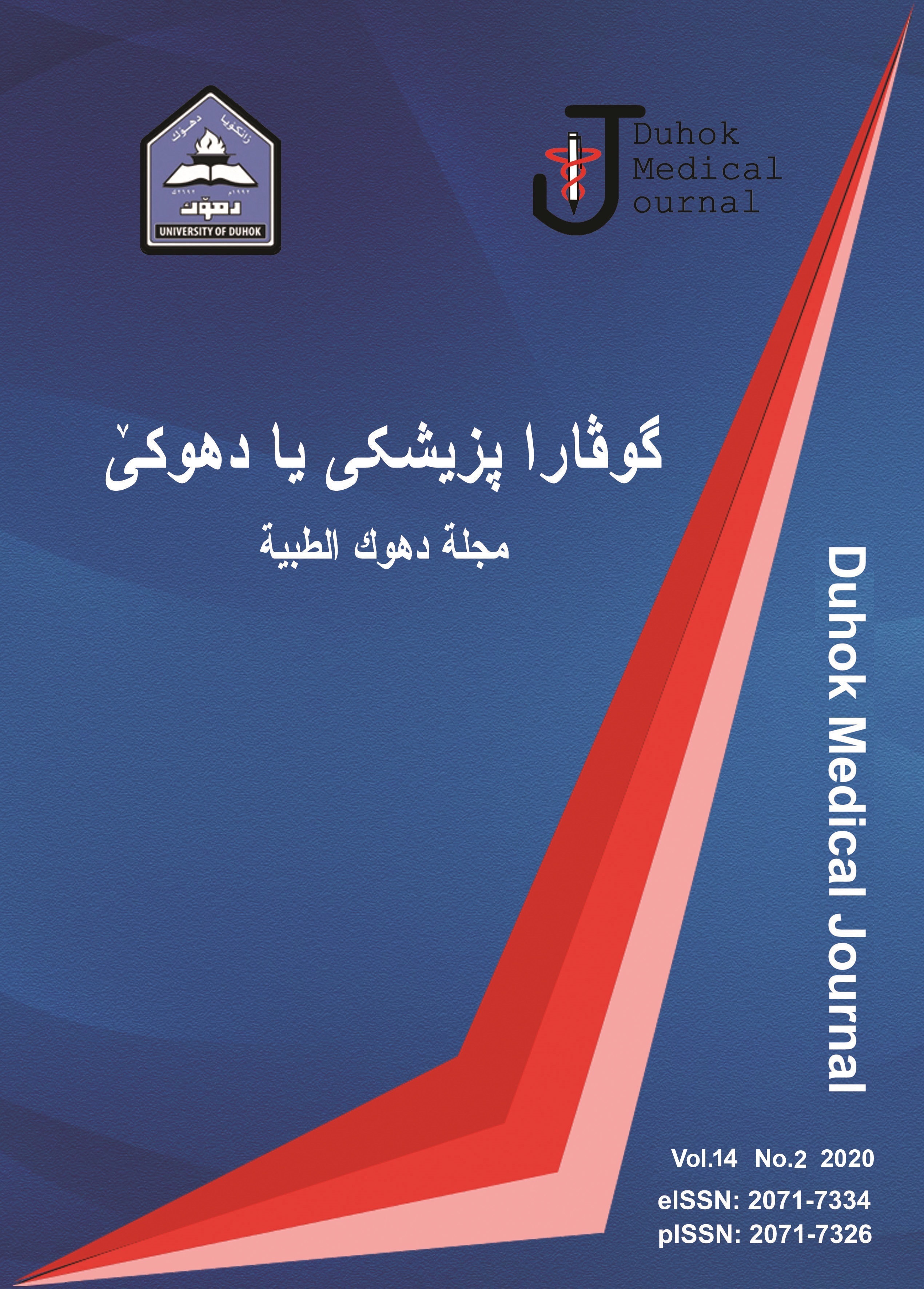POLYCYSTIC OVARY SYNDROME IN DUHOK: CLINICAL AND BIOCHEMICAL CHARACTERIZATION
Abstract
https://doi.org/10.31386/dmj.2020.14.2.10
Background: Polycystic ovary syndrome is a complex, heterogeneous disorder that affects 5-10 % of women in their reproductive age, causing a range of reproductive, metabolic, and endocrine defects characterized by chronic anovulation, hyperandrogenism, and polycystic ovaries. It manifests differently depending on many interacting factors, including environmental exposures, genetics, and lifestyle.
Objectives: This study aimed to assess the clinical and biochemical findings of local cases of the syndrome.
Methods: This cross-sectional study was carried out during the period from 01 June to 01 December 2019, at Duhok Azadi teaching hospital and the outpatient departments of Zakho maternity hospital and Kurdistan medical complex. The 108 eligible patients according to Rotterdam ESHRE/ASRM criteria were interviewed and examined by the investigator to find out and document the required data following the adopted questionnaire, which included patient's history, clinical examination, laboratory investigation, and abdominal ultrasound. The statistical package SPSS version 19 was used to analyze study variables. The statistical analyses used were Chi-square, Mann-Whitney test, and Unpaired t-test.
Results: The mean age of the enrolled women was 24.3 ± 5.54, the majority (81.5%) was below 30 years old and (70.6%) were overweight, (50.9%) were unmarried, and (68.5%) were having secondary school/college educational levels with (51.9%) giving the family history of PCOS. Menstrual cycle disturbances were detected in (97.2%) and infertility history (27.8%). The most common finding was hirsutism (86.1%), followed by generalized alopecia (62%). Polycystic ovaries were detected in (75.3%) on U/S examination.
Conclusions: In local practice, menstrual abnormalities, mostly as hypomenorrhea and oligomenorrhea, constituted the most common presentation. On the other hand, the concurrent presence of hyperandrogenism and positive ultrasound findings were more stable features and may be suggested as a better indicator for establishing the diagnosis of the syndrome locally.
Downloads
References
2. Dhaded S, Dabshetty S.Role of circulation miRNA in patients suffering with polycystic ovary syndrome (PCOS). International Journal of Clinical Obstetrics and Gynaecology. 2018; 2(3): 92-95.
3. Zhang XZ, Pang YL, Wang X, Li YH. Computational characterization and identification of human polycystic ovary syndrome genes.Scientific reports. 2018; 8(1): 1-7.
4. Rotterdam ESHRE/ASRM. Sponsored PCOS Consensus Workshop Group. Revised 2003 consensus on diagnostic criteria and long term health risks related to polycystic ovary syndrome (PCOS). Human reproduction. 2004; 19(1): 41-47.
5. Jamil AS, Alalaf SK, Al-Tawil NG, Al-Shawaf T. Comparison of clinical and hormonal characteristics among four phenotypes of polycystic ovary syndrome based on the Rotterdam criteria. 2016; 293: 447-56.
6. Moghadam ZB, Fereidooni B, Saffari M, Montazeri A. Measures of health-related quality of life in PCOS women: a systematic review. Int J Women's Health. 2018; 10: 397.
7. Kabel AM., Alghubayshi AY. and Moharm, FM. The impact of polycystic ovarian syndrome, a potential risk factor to endometrial cancer, on the quality of sleep. Journal of Cancer Research and Treatment. 2016; 4(6):96-8.
8. Joshi B, Mukherjee S, Patil A, Purandare A, Chauhan S, Vaidya R. A cross-sectional study of polycystic ovarian syndrome among adolescent and young girls in Mumbai, India. Indian J EndocrinolMetab. 2014; 18(3): 317-34.
9. Rong L, Zhang Q,Yang D, Li S, Lu S, Wu X, et al. Prevalence of polycystic ovary syndrome in women in China: a large community-based study. Human reproduction. 2013; 28(9): 2562-9.
10. Azziz R, Carmina E, Dewailly D, Diamanti-Kandarakis E, Escobar-Morreale HF, Futterweit W, et al. The Androgen Excess and PCOS Society criteria for the polycystic ovary syndrome: the complete task force report. Fertility and sterility. 2009; 91(2): 456-88.
11. Najem FI, Elmehdawi RR. Swalem AM. Clinical and biochemical characteristics of polycystic ovary syndrome in Benghazi-Libya; a retrospective study. Libyan J Med. 2008; 3(2): 71-4.
12. Quinn M., Shinkai K, Pasch L, Kuzmich L, Cedars M, Huddleston H. Prevalence of androgenic alopecia in patients with polycystic ovary syndrome and characterization of associated clinical and biochemical features. Fertil Steril. 2014; 101(4): 1129-34.
13. Li L, Yang D, Chen X, Chen Y, Feng S, Wang L. Clinical and metabolic features of polycystic ovary syndrome. International Journal of Gynecology & Obstetrics. 2007; 97 (2): 129-34.
14. Wolf WM, Wattick RA, Kinkade ON, Olfert D. Geographical prevalence of polycystic ovary syndrome as determined by region and race/ethnicity. International journal of environmental research and public health. 2018; 15(11): 2589.
15. Choudhary A, Jain S, Chaudhari P. Prevalence and symptomatology of polycystic ovarian syndrome in Indian women: is there a rising incidence. International Journal of Reproduction, Contraception, Obstetrics and Gynecology. 2017; 6(11): 4971-75.
16. Bharathi RV, Swetha S, Neerajaa J, Madhavica JV, Janani DM, Rekha SN, et al. An epidemiological survey: Effect of predisposing factors for PCOS in Indian urban and rural population. Middle East Fertility Society Journal. 2017; 22(4): 313-6.
17. Shinde KS, Patil SS. Incidence and risk factors of polycystic ovary syndrome among women in reproductive age group attending a tertiary health care hospital in western Maharashtra. International journal of Reproduction, Obstetrics and Gynecology. 2019; 8(7): 2804-09.
18. Balen AH, Laven JS, Tan SL, Dewailly D. Ultrasound assessment of the polycystic ovary: international consensus definitions. Human reproduction update. 2003; 9(6): 505-14.
19. Iwasa T, Matsuzaki T, Minakuchi M, Tanaka N, Shimizu , Hirata Y, et al. Diagnostic performance of serum total testosterone for Japanese patients with polycystic ovary syndrome. Endocr J. 2007; 54(2):233–38.






